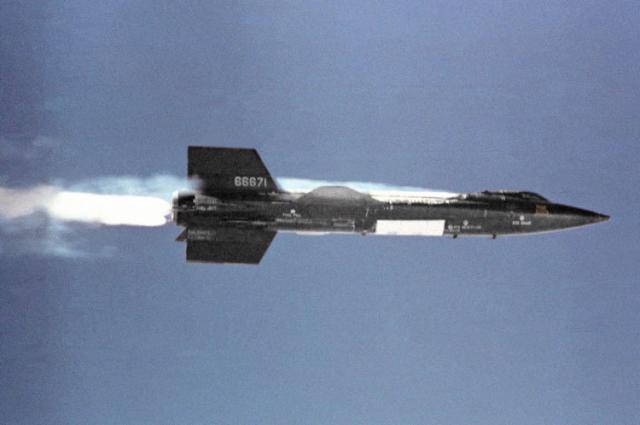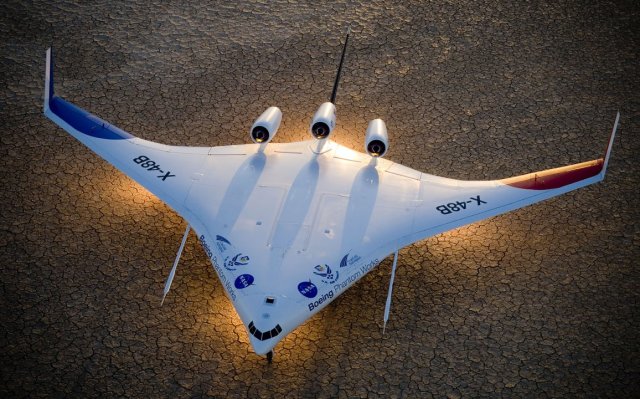
X-Planes
X-plane is the legendary designation of an experimental US aircraft, such as the North American X-15. An X-plane is typically designed to explore the boundaries of technology in pursuit of higher speed, altitude and maneuverability.
 North American X-15Image courtesy of NASA Dryden Flight Research Center Photo Collection
North American X-15Image courtesy of NASA Dryden Flight Research Center Photo Collection
Early Days
In the aftermath of World War II, without access to today's higher performance computing resources to perform Computer-Aided Engineering (CAE) analysis such as Computational Fluid Dynamics (CFD), designers took to building and testing experimental aircraft to explore then unknown phenomenon such as supersonic flight. Probably the two best known X-planes are:
- Bell X-1 - the first airplane to break the sound barrier (Mach 1) in level flight (1947)
- North American X-15 - set numerous speed and altitude records in reaching the edge of space (1959-1968)
Another noteworthy early X-plane was the X-24 (1963-1975), which explored the gliding characteristics of lifting bodies for atmosphere reentry. The findings from the X-24 and the gliding concept were used by the Space Shuttle.
A series of X-planes (X-13, X-14, X-18, X-19 and X-22) during the 1950s and 1960s investigated vertical takeoff and landing using various concepts. The tilt-rotor system pioneered by the X-18 and X-19 was successfully used in the V-22 Osprey.
X-Planes Evolve
The variation and scope of early X-planes was breathtaking. As simulation tools improved, however fewer X-planes made actual flights - instead evaluations were performed virtually inside high performance computers. A major tool used for aerodynamic concept evaluation is CFD. CFD can analyze the entire air flow range from creeping (flying insects) to hypersonic (shuttle reentry) speeds. It is much more cost effective to use CFD to evaluate aircraft performance than to build an aircraft and conduct physical flight tests.
 X-48B Blended Wing BodyImage courtesy of NASA
X-48B Blended Wing BodyImage courtesy of NASA
When physical testing is deemed necessary, there is a strong case (i.e., reducing cost and risk to pilots' lives) to conduct unmanned flights of scaled models, as with the X-48B blended wing body. In fact, it is highly likely that the majority of future combat aircraft will be unmanned, as demonstrated by the Northrop Grumman X-47 Pegasus.
Spirit of X-Planes
Immediately after World War II, governments were the only bodies willing to risk vast sums of money on advanced (risky) aircraft concepts, as demonstrated by the funding of X-plane projects in the US. Progress was rapid but costly. Recently we've seen the (re)introduction of prizes, such as the Ansari X-Prize won by SpaceShipOne, to stimulate private enterprise's interest in high risk ventures and to encourage technology advances. Funded by non-government organizations and wealthy individuals, we've entered a new golden age of aerospace experimentation (e.g., flying cars) in pursuit of prizes, profits and in some cases just for fun.
While we were inspired by the X-planes of old, we now have available advanced CAE tools that have significantly reduced the need to build expensive physical prototypes in order to evaluate a concept. This democratization fueled by the availability of affordable CAE analysis software, such as Caedium Professional, means X-planes can roll off virtual production lines anywhere, anytime.
Recent blog posts
- CFD Simulates Distant Past
- Background on the Caedium v6.0 Release
- Long-Necked Dinosaurs Succumb To CFD
- CFD Provides Insight Into Mystery Fossils
- Wind Turbine Design According to Insects
- Runners Discover Drafting
- Wind Tunnel and CFD Reveal Best Cycling Tuck
- Active Aerodynamics on the Lamborghini Huracán Performante
- Fluidic Logic
- Stonehenge Vortex Revealed as April Fools' Day Distortion Field

Comments
CFD Use in X-Plane Design
The recent NASA report "Computational Fluid Dynamics Analysis Success Stories of X-plane Design to Flight Test", NASA/TM-2008-214636, May 2008 (pdf) highlighted the value of CFD in recent X-Plane designs (X-36, X-45A and X-48B). The summary says it all:
"This report presented and described examples of successful application of computational fluid dynamics (CFD) analysis to the design process of three true X-planes. The process of conceptual design, computer-aided design modeling and refinement followed by CFD analysis methods application and further refinement was described. Specifically, how CFD analysis can aid in the design of a wind tunnel model that will yield few if any surprises during wind tunnel testing was explained. In the wind tunnel, data can be directly correlated to the computed CFD analysis database, thus calibrating the CFD analysis methodology and in some cases validating the wind tunnel data reduction method.
Computational fluid dynamics analysis can be and has been an enabling technology in the development process of getting a new aircraft shape into flight. Controlling an inherently unstable configuration is critically dependent on determination of the aerodynamics and stability derivatives of the configuration; CFD can provide preliminary estimates of these quantities accurately enough for the development of early control laws and a flyable simulation. Configuration assessments and incremental redesign can then be accomplished in a deliberate fashion, with the goal of arriving at a final configuration committed to a more detailed analysis, leading toward a flight model with greatly improved chances of success."